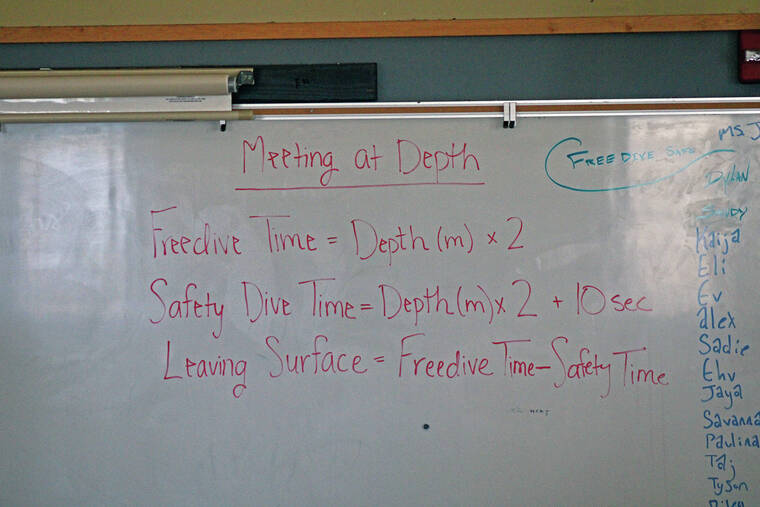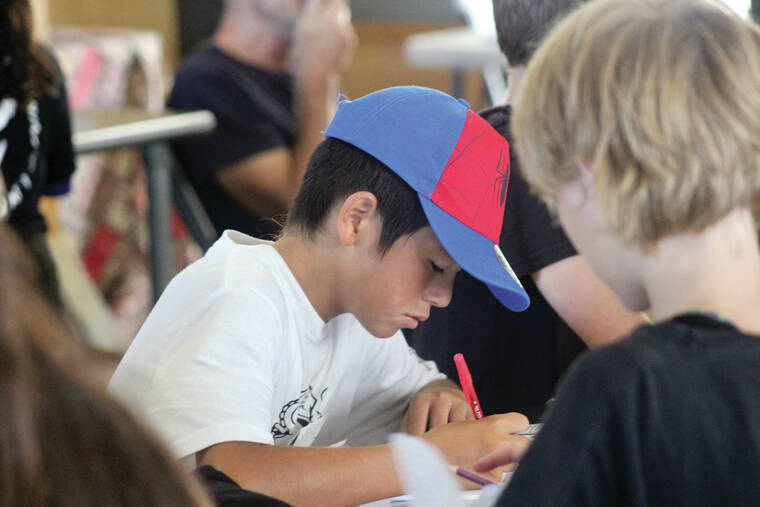KAILUA-KONA — It’s never too early to mitigate risks, and perhaps no one knows that better than West Hawaii Explorations Academy.
History was made over the last week at the project-based charter school. WHEA is the first public institution in the United States to offer in-school freediving safety courses, both in the classroom and in the water.
The school worked closely with FreediveSafe! Hawaii — a freediving and spearfishing safety foundation — to teach the curriculum to ages 12 and up for the second straight year, completely free.
“These freediving courses have always been very expensive and somewhat exclusive to the greater community, just due to the price point of it,” FreediveSafe! Hawaii Lead Educator and Head of Program Development Dylan Currier told West Hawaii Today. “So what we’re trying to do with Freedivesafe! Hawaii is provide this education free of charge and open to everyone and anyone that needs it — whether it’s because they spend time in the ocean, for fun, spearfishing for food with their families, or if it’s just part of their upbringing.”
“We just want our students to come to school safe, but the reality is, outside of the classroom, they dive and spearfish,” WHEA educator Julia Donath added. “And if we have an opportunity to make that safer for them, I think we have a responsibility as educators to provide that to them.”
The idea began during the 2022-23 school year, when two WHEA ninth-grade students approached Donath about water safety. Being a hands-on institution, the students wanted to explore freediving’s impact on the mind and body in a therapeutic sense as part of their education.
As a freediving instructor herself, Donath supported the proposal — and the partnership between WHEA and FreediveSafe! only snowballed. High school students interested in the project then assisted Donath in creating engaging games focused on freediving safety to support WHEA’s middle school students.
“We have a group of veterans from the high school that went through the program, either last year with us or just last week with us that have received this training,” Currier said. “They’re stepping up to the plate to work as mentors and role models for the younger classmates.
“And they also help us be organized with the way that we handle all the gear in running this event. So it’s really great to see their interest in getting involved more and more.”
The additional concerns about water-related deaths rising during the pandemic helped spark the new program to life. Per the state Department of Health, drowning is the fifth-leading cause of death among Hawaii residents — averaging around 40 per year.
“It’s very preventable,” Currier said of the uptick of drowning deaths. “When you have the knowledge, skills and information and you just apply it every time, you are able to set up a safe freediving environment if you follow procedures.”
“I want to know I’ve done everything in my power to prevent one of our school’s students from being the next tragic statistic in Hawaii’s list of freediving-related fatalities, and I’m overwhelmingly lucky to work at a school like WHEA that supports these initiatives for our youth,” Donath added.
This past Friday, a multihour class on diving safety elements such as oxygen awareness, buddy systems, proper gear and rescue techniques took place for WHEA middle-schoolers in the first of their two-part curriculum. WHEA high school students, staff and FreediveSafe! instructors helped run the keki-friendly environment.
“After taking safety courses provided by FreeDiveSafe!, students can use the scientific method and run experiments related to freediving — fulfilling components of their science curriculum,” Donath said. “It’s culturally-relevant, place-based science education that allows students to learn in ways that are meaningful to them, while also benefiting them outside of the classroom.”
Students continued the program at the Kona Community Aquatic Center on Monday for the pragmatic portion of the course — applying what they learned in last Friday’s session to the water. With this year’s program now in the rearview, WHEA students have safety skills that can be used for the rest of their lives.
“We see the value in why kids should know this stuff, because it’s only going to make them safer and smarter when they’re in the water,” Currier said. “Whether they’re surfing, diving or snorkeling — we just want everyone to come home safe at the end of the day. … One of the main things that we’re trying to do with our impact on the community is to try to change the mentality around diving. Getting away from the bravado, old-school mentality of ‘just getting out there.’
“That mentality was from the last generation of divers, which makes sense because we didn’t know what we know now. With all the science that’s been available the last two decades, we can drastically change the sport.”
In addition to trying to make a difference in WHEA students’ lives, FreediveSafe! hopes to help set a precedent that others schools will eventually follow.
“We hope we get everyone to understand the value of incorporating freediving safety into youth enrichment, just like swim safety and lifeguard training,” Currier said. “Ocean safety is a very dynamic and complex situation that requires awareness in a lot of different fields.”


